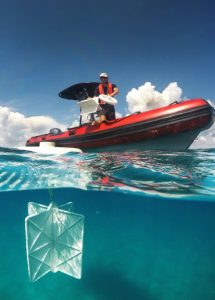Study Describes Design and Testing of an Effective Biodegradable Ocean Drifter
– JULY 12, 2018
Scientists detailed how they designed and tested an ocean drifter that tracks and measures shallow-depth (0.60 m) surface currents. The final version, called the CARTHE drifter, is made from a polymer produced by bacteria fed with corn sugar. The affordable and off-the-shelf electronic components include mercury- and lead-free alkaline battery packs not classified as hazardous by the U.S. Environmental Protection Agency. The team analyzed the motion of scaled models in a wind-wave-current flume, field tested full-scale models, and validated their trajectories against a well-established drifter model. Then, they produced and deployed over 1,000 units for the Lagrangian Submesoscale Experiment (LASER) campaign, which successfully tracked submesoscale features in the Gulf of Mexico. Because this technology is affordable and can be mass produced, it is transferable from academia to the private and public sector. The researchers published their findings in the Journal of Atmospheric and Oceanic Technology: A biodegradable surface drifter for ocean sampling on a massive scale.
Drifter tracking is the oldest way to measure currents; however, submesoscale currents (typically 102 – 104 meters in length and hours to days in time scales) have been understudied. These small-scale currents induce strong surface rotation or spinning and divergence fields that can cause floating material to initially cluster and then disperse and spread out. The LASER campaign sought to capture submesoscale events with the appropriate spatiotemporal resolution, which would require an improved drifter design and the deployment of the most drifters ever.
The team tested several drifter designs in the University of Miami’s Surge Structure Atmosphere Interaction (SUSTAIN) facility. The final CARTHE drifter version retained its velocity under short and steep wave activity and at all tested wind speeds, as its flexible tether reduced wave rectification and the drogue anchored the drifter in the water. The team conducted field trials and compared the behavior of their drifter design to the well-established CODE drifter and observed no significant difference between their average velocities and travel direction.
Manufactured by injection modeling, the final design included a torus float with an integrated GPS/battery compartment, a GPS enclosure lid, two interlocking drogue panels, a flexible tether link made from natural rubber tubing, and non-stainless-steel fasteners that can rust away in the ocean. The team used biploymer polyhydroxyalkanoates (PHA), which do not absorb water and biodegrade in seawater and sediments.
“It took about 3 years of testing, researching, and redesigning the drifter to obtain this accurate scientific instrument,” said study author Guillaume Novelli. “This higher-resolution picture of the ocean revealed previously unseen organized currents that explain how floating material sometimes concentrates (oil, garbage patch, weed lines, algae blooms) and sometimes disperses and spreads (oil spills coming to shore, Fukushima fishing boats reaching US West coast years after the tsunami). The surface current data that CARTHE drifters collected is crucial to improving and validating ocean circulation models and validating instruments that measure currents remotely, such as X-band marine radar, polarimetric camera slope sensing, AirSWOT, and DopplerScat.”
Researchers have used CARTHE drifters in other investigations, such as in the sensitive environments of the Arctic’s Beaufort Sea and in Miami’s Biscayne Bay.
Watch these award-wining videos to learn more about the CARTHE drifter technology:
- “Drifting in the Gulf” video, a humorous clip about the drifter design process.
- “Motion of the Ocean” video, a student-friendly clip about drifter experiments.
Data are publicly available through the Gulf of Mexico Research Initiative Information & Data Cooperative (GRIIDC) at doi:10.7266/N7VH5KWX.
The study’s authors are Guillaume Novelli, Cedric Guigand, Charles Cousin, Ed Ryan, Nathan Laxague, Hanjing Dai, Brian Haus, and Tamay Özgökmen.
************
This research was made possible in part by a grant from the Gulf of Mexico Research Initiative (GoMRI) to the Consortium for Advanced Research on Transport of Hydrocarbon in the Environment II (CARTHE II).
The Gulf of Mexico Research Initiative (GoMRI) is a 10-year independent research program established to study the effect, and the potential associated impact, of hydrocarbon releases on the environment and public health, as well as to develop improved spill mitigation, oil detection, characterization and remediation technologies. An independent and academic 20-member Research Board makes the funding and research direction decisions to ensure the intellectual quality, effectiveness and academic independence of the GoMRI research. All research data, findings and publications will be made publicly available. The program was established through a $500 million financial commitment from BP. For more information, visit https://gulfresearchinitiative.org/.
© Copyright 2010-2018 Gulf of Mexico Research Initiative (GoMRI) – All Rights Reserved. Redistribution is encouraged with acknowledgement to the Gulf of Mexico Research Initiative (GoMRI). Please credit images and/or videos as done in each article. Questions? Contact web-content editor Nilde “Maggie” Dannreuther, Northern Gulf Institute, Mississippi State University (maggied@ngi.msstate.edu).






